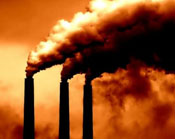The Grand Challenges
 |
Carbon Sequestration |
Carbon sequestration is the capture and long-term storage of carbon dioxide and other greenhouse gases that would otherwise be emitted into the atmosphere. The greenhouse gases can be captured at the point of emission (direct sequestration), or removed from the air (indirect sequestration). The captured gases can be stored in underground reservoirs (geological sequestration), injected deep into oceans (ocean sequestration), stored in vegetation and soils (terrestrial sequestration), or converted to rock-like solid materials (advanced concepts).
Methods already exist for key parts of the sequestration process. A chemical system for capturing carbon dioxide is already used at some facilities for commercial purposes, such as beverage carbonation and dry ice manufacture. The same approach could be adapted for coal-burning electric power plants, where smokestacks could be replaced with absorption towers. One tower would contain chemicals that isolate carbon dioxide from the other gases (nitrogen and water vapor) that escape into the air and absorb it. A second tower would separate the carbon dioxide from the absorbing chemicals, allowing them to be returned to the first tower for reuse.
A variation to this approach would alter the combustion process at the outset, burning coal in pure oxygen rather than ordinary air. That would make separating the carbon dioxide from the exhaust much easier, as it would be mixed only with water vapor, and not with nitrogen. It’s relatively simple to condense the water vapor, leaving pure carbon dioxide gas that can be piped away for storage.
In this case, though, a different separation problem emerges — the initial need for pure oxygen, which is created by separating it from nitrogen and other trace gases in the air. If that process can be made economical, it would be feasible to retrofit existing power plants with a pure oxygen combustion system, simplifying and reducing the cost of carbon dioxide capture.
Advanced methods for generating power from coal might also provide opportunities for capturing carbon dioxide. In coal-gasification units, an emerging technology, coal is burned to produce a synthetic gas, typically containing hydrogen and carbon monoxide. Adding steam, along with a catalyst, to the synthetic gas converts the carbon monoxide into additional hydrogen and carbon dioxide that can be filtered out of the system. The hydrogen can be used in a gas turbine (similar to a jet engine) to produce electric power.
